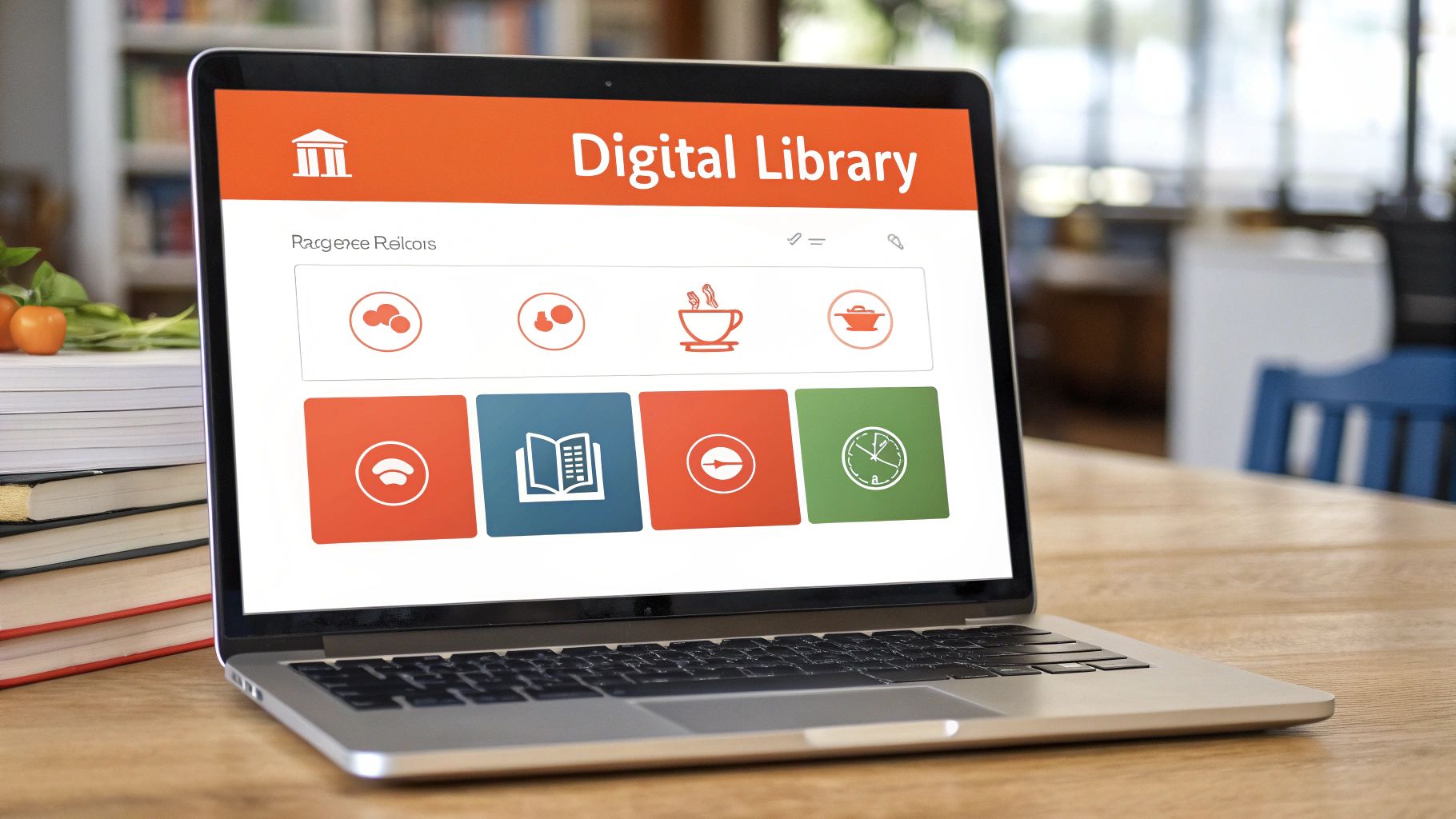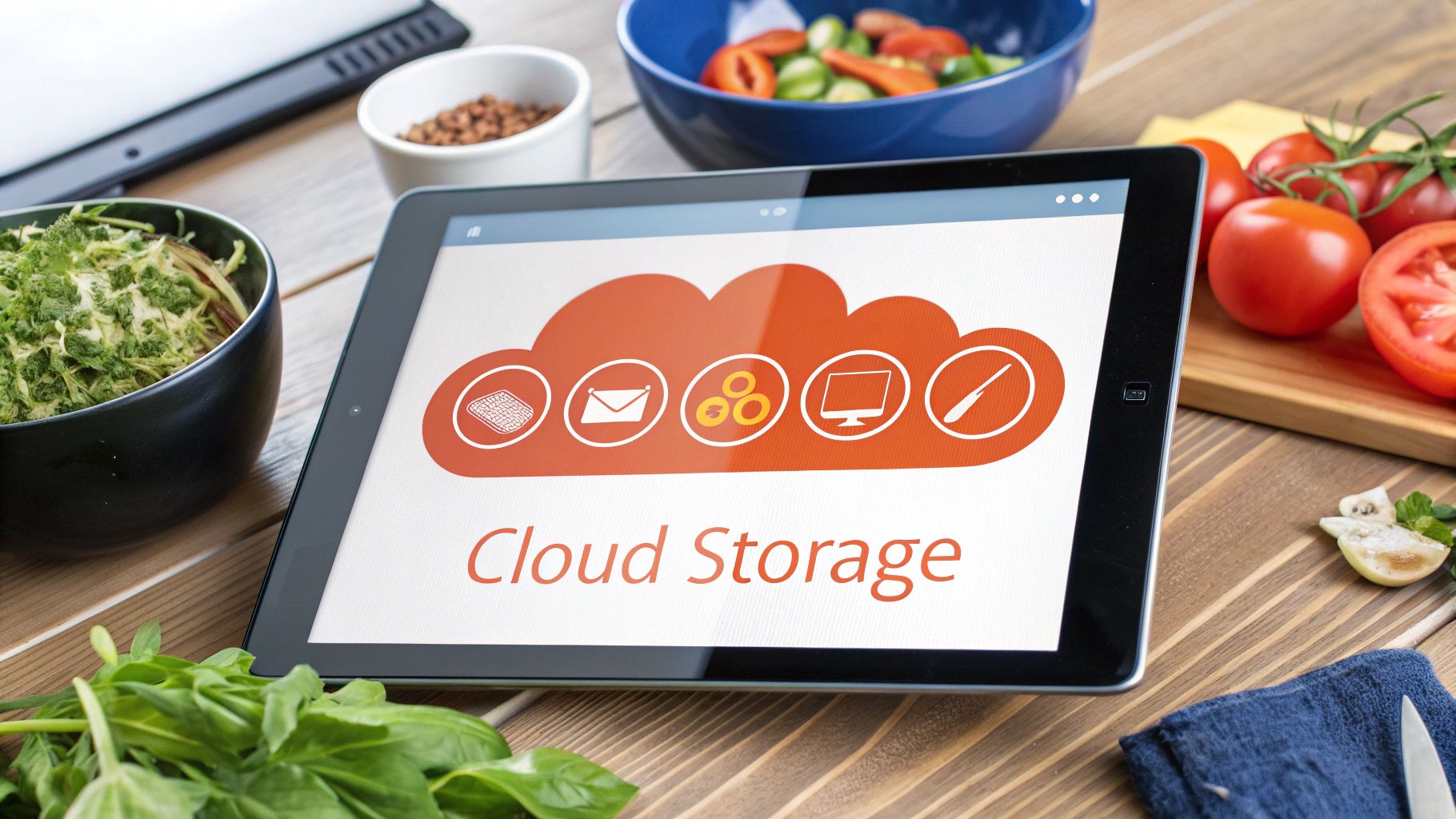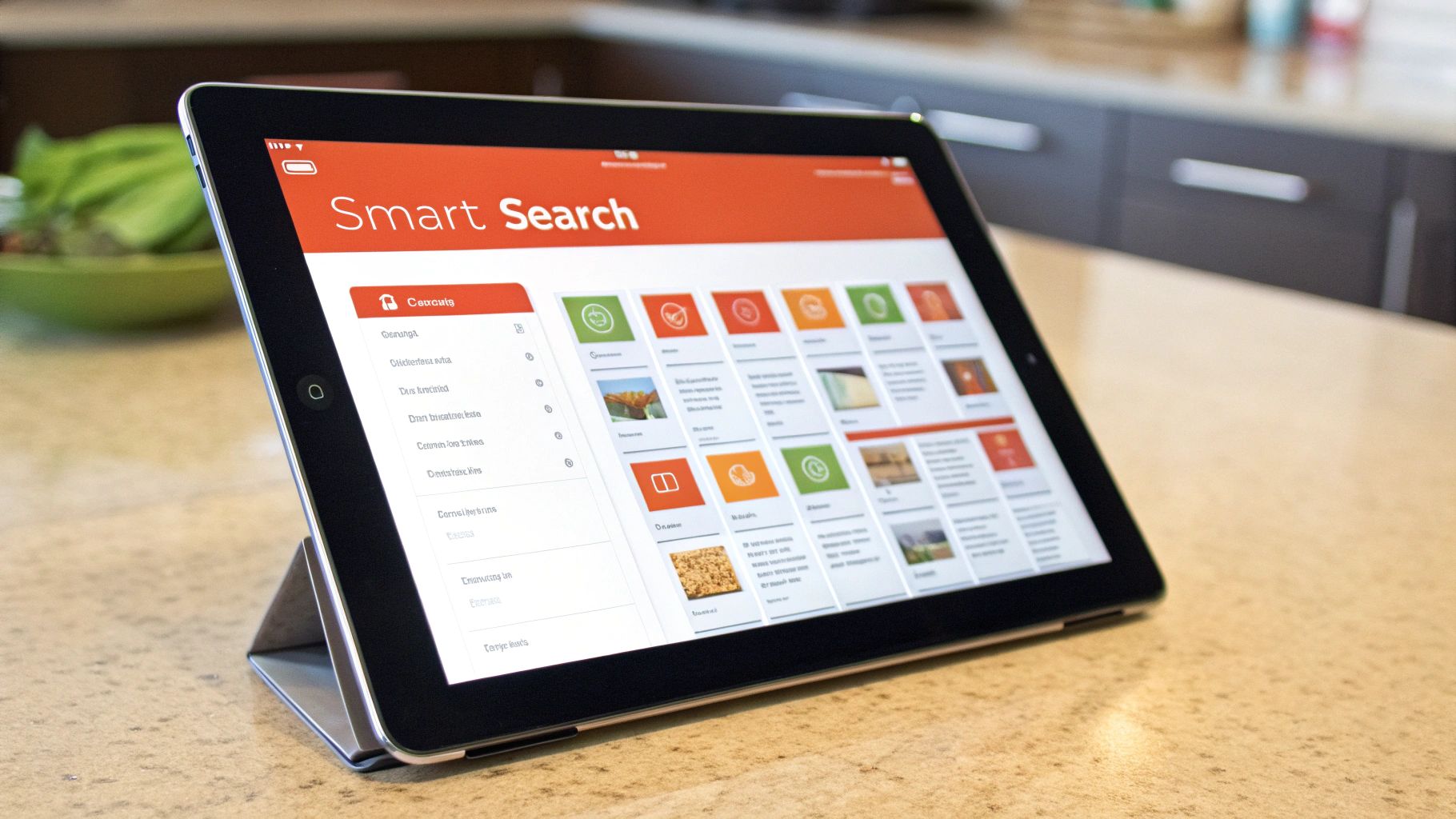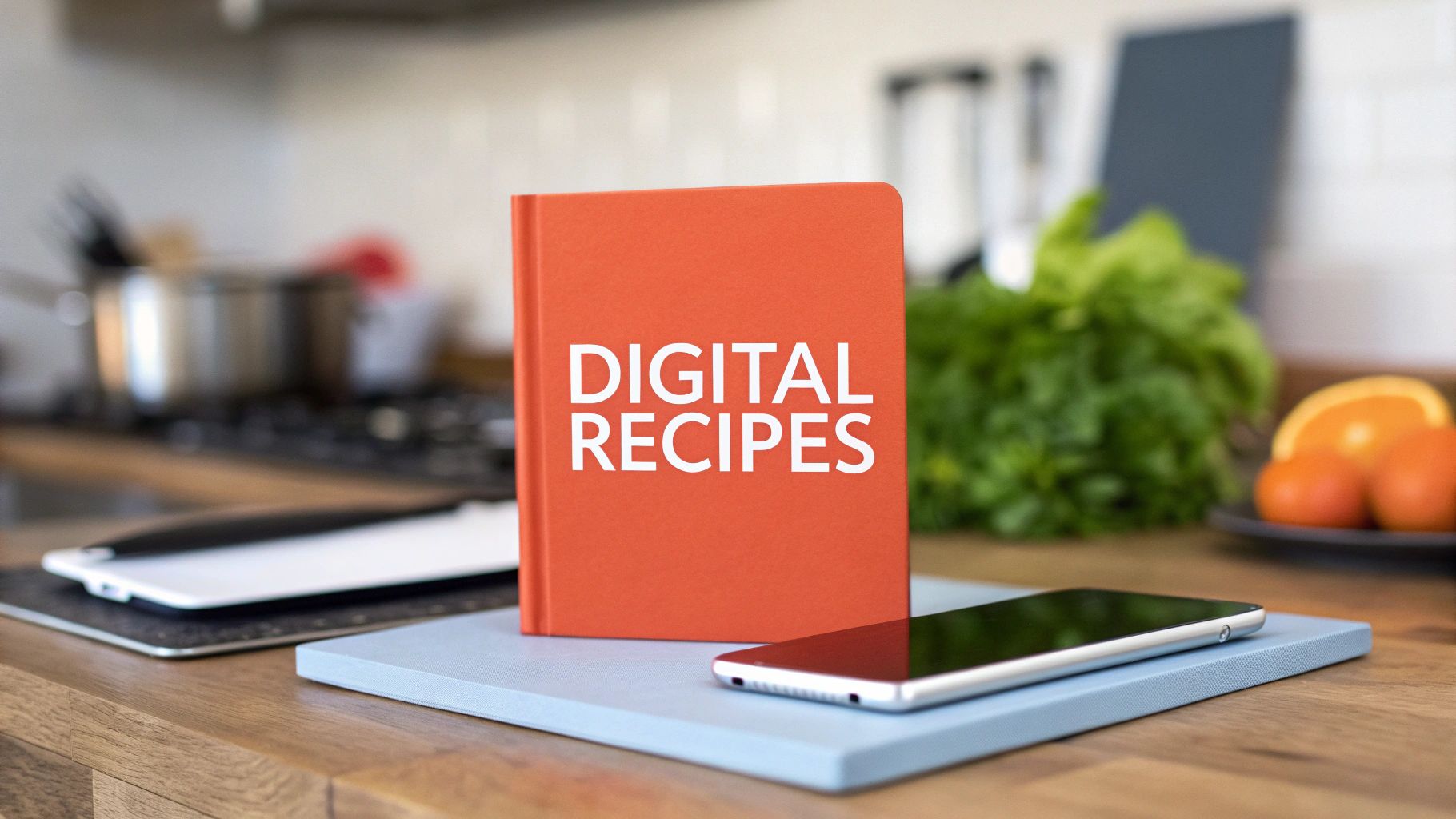Why Digital Recipe Storage Is Revolutionizing Home Cooking

The best way to store recipes online goes beyond simple convenience. It's a whole new way of thinking about food and cooking. Forget frantic searches through overflowing recipe boxes or stained cookbooks. Digital organization creates a centralized, easily searchable hub for all your culinary treasures.
This easy access turns meal planning from a chore into a joy. Imagine effortlessly browsing your recipes on your phone as you stroll through the grocery store. This instant access sparks creativity and encourages you to try new dishes.
Accessibility and Security: The Cornerstones of Digital Recipe Management
A key advantage of digital storage is access to your recipes from any device, anytime. Whether you're at home on your tablet, at the grocery store on your phone, or visiting family on your laptop, your recipes are always at hand. Plus, cloud-based storage like Dropbox adds extra security.
This means even if your device is lost or damaged, your recipes are safe. Unlike physical recipe cards or cookbooks, digital copies ensure your family's culinary heritage is preserved. This peace of mind is a compelling reason to go digital.
Sharing and Collaboration: Fostering Culinary Connections
Digital storage simplifies sharing recipes. No more photocopying or emailing lengthy instructions. With a few clicks, share your culinary creations with loved ones near and far. This builds community and connection through food.
Many online platforms facilitate collaborative recipe collections. Families can contribute and preserve their shared culinary history. This creates a living archive of family recipes, enriching traditions and strengthening bonds. The digital recipe consumption market has seen significant growth, reflecting this shift from traditional cookbooks to digital platforms.
As of 2024, this market was valued at USD 625.91 million and is projected to reach USD 1,706.30 million by 2031, growing at a CAGR of 15.40%. This growth is driven by technology and changing consumer preferences like increased smartphone use and wider internet access. Explore this topic further here. This trend highlights the growing popularity and potential of digital recipe management.
Efficiency and Inspiration: Transforming Your Kitchen Experience
Finally, the best way to store recipes online drastically improves kitchen efficiency. Searchable databases, adjustable serving sizes, and automatic shopping list features streamline cooking. This means less time searching and more time enjoying the art of cooking.
The vast number of online recipes provides endless inspiration, broadening your culinary horizons. Digital recipe storage isn't just a convenient tool; it's a catalyst for a more fulfilling cooking experience.
Master Apps For Storing Recipes: A Practical Comparison

Finding the perfect online recipe storage solution can be tricky with so many choices. Knowing what you need helps narrow the field. Some cooks prefer dedicated recipe apps, while others find general cloud storage works best. This section compares both, helping you discover the right fit for your kitchen. For more tips, check out this guide on organizing recipes online.
Specialized Recipe Apps: Designed For The Culinary Enthusiast
Specialized recipe apps like Paprika and Whisk offer features tailored to recipe management. Think ingredient scaling, meal planning, and built-in shopping lists. These platforms make organizing and using recipes easier. Many also sync across devices, so your recipes are always at hand. Keep in mind, some apps require subscriptions, so weigh the cost against the features.
- Key benefits of specialized recipe apps:
- Recipe-centric features: Tools made specifically for working with recipes.
- Cross-device syncing: Access your recipes anywhere.
- Meal planning integration: Simplify weekly menus.
- Shopping list automation: Create grocery lists from your recipes.
Cloud Storage Solutions: Flexible and Accessible Recipe Management
Cloud storage services like Google Drive, Dropbox, or Notion offer a flexible way to store recipes. They’re accessible and great for collaboration. Sharing recipes with family is easy with shared folders, allowing you to build a living archive of cherished recipes. While cloud storage is versatile, the best choice depends on your usage.
To help you make an informed decision, let's compare some popular options. The table below details key features and pricing for several leading recipe storage apps:
Top Recipe Storage Apps Comparison: Comprehensive comparison of leading recipe storage applications across key features and pricing
| App Name | Best For | Key Features | Pricing | Platform Availability | User Rating (Example) |
|---|---|---|---|---|---|
| Paprika | Serious home cooks | Recipe import, scaling, meal planning, grocery lists | One-time purchase | iOS, Android, macOS, Windows | 4.5 stars |
| Whisk | Meal planning and grocery shopping | Recipe import, meal planning, grocery lists, connected kitchen appliances | Free | iOS, Android, Web | 4.0 stars |
| Plan to Eat | Detailed meal planning | Meal planning, grocery lists, recipe import, inventory management | Subscription | iOS, Android, Web | 4.7 stars |
| Google Drive | Flexible storage and sharing | File storage, sharing, collaboration | Free and paid plans | iOS, Android, Web | 4.3 stars |
| Dropbox | Simple file storage and sharing | File storage, sharing, backup | Free and paid plans | iOS, Android, Web | 4.4 stars |
| Notion | Customizable organization | Note-taking, databases, project management | Free and paid plans | iOS, Android, Web | 4.0 stars |
This table highlights the diverse range of features and pricing models available. Choosing the right app depends on your individual needs and preferences.
The recipe app market is booming due to trends like increased home cooking and health awareness. In 2024, the market was valued at $1.25 billion, and it's projected to reach $1.41 billion in 2025, a 13.5% growth. By 2029, it’s expected to hit $2.32 billion, driven by personalized nutrition, smart kitchen device integration, and specialized diets.
- Key benefits of cloud storage solutions:
- Cost-effective: Free options are available.
- Accessibility: Access recipes from any device with internet.
- Collaboration: Share recipes with ease.
- Flexibility: Adapt the system to how you work.
Choosing The Right Approach: Finding Your Perfect Recipe Home
The ideal recipe storage depends on your cooking style and tech comfort. If dedicated tools are appealing, explore specialized apps. If you value flexibility and collaboration, cloud storage might be better. Think about cost, ease of use, and how you’ll use your recipes. The right choice makes cooking more enjoyable and less stressful.
Specialized Apps Vs. Cloud Systems: Making The Right Choice

Deciding where to store your precious recipes online often comes down to two options: specialized recipe apps or general cloud storage systems. Both have their pros and cons, impacting how you organize recipes and plan meals. Understanding these differences is crucial for finding the perfect digital recipe home.
Recipe Apps: A Kitchen-Focused Approach
Recipe apps are purpose-built for managing recipes. They often include features like ingredient scaling, meal planning tools, and automatic shopping list creation. For example, apps like Paprika let you easily adjust serving sizes, organize recipes into collections, and sync your data across multiple devices. This creates a centralized, kitchen-centric hub for all your recipe needs.
However, these apps often come with a cost, either a one-time purchase or a subscription. Also, their specialized nature might feel restrictive if you prefer a more adaptable organizational style.
- Key Benefits of Recipe Apps:
- Built-in recipe-specific tools
- Cross-device synchronization
- Meal planning features
- Automatic shopping list creation
Cloud Storage Systems: Flexibility and Collaboration
Cloud storage systems like Google Drive, Dropbox, and Notion offer a different solution. While not designed specifically for recipes, their adaptability allows you to tailor the system to your specific preferences. You can create shared folders for collaborative family cookbooks, use tags for detailed organization, or integrate recipes into broader life management systems.
This makes cloud storage powerful for those who appreciate customization. Cloud storage also offers budget-friendly choices, including free plans with plenty of storage for most recipe collections. This affordability, combined with simple sharing features, makes it a strong option for storing recipes online. This ease of sharing is evident in the rise of online recipe usage. 91% of American consumers now use online recipes, a significant increase from previous years. 60% report increased usage compared to just a year ago. Find more statistics here.
- Key Benefits of Cloud Storage Systems:
- Cost-effective storage options
- Customizable organization
- Easy sharing and collaboration
- Broad platform accessibility
Data Portability and Future-Proofing Your Collection
Choosing how to store your recipes online also means thinking about the future. Things like data portability and future-proofing are key considerations. Recipe apps often keep your data locked within their system, making it difficult to move to a different platform. Cloud storage typically provides easy export choices, giving you greater control over your data. This is vital for ensuring your recipes remain accessible, no matter what technological advancements may come.
Making The Right Choice For Your Needs
Ultimately, the ideal recipe storage solution depends on your cooking habits and comfort with technology. Recipe apps provide a focused, feature-rich environment for dedicated cooks. Cloud storage offers flexibility and collaboration for those who prefer a tailored system. Weigh the pros and cons of each, considering factors like cost, ease of use, and long-term access.
Think about integrating with other platforms, like Recify, which allows you to import recipes from numerous online sources and organize them in one place. This integration can further enhance your recipe management and keep your recipes at your fingertips.
Building a Mobile-First Recipe Collection That Works Anywhere
For today's cooks, having recipes at their fingertips is key, whether they're at the grocery store, traveling, or visiting friends. This section explores creating a truly mobile-friendly recipe collection. We'll cover how to format recipes for easy reading on smaller screens, the convenience of hands-free cooking with voice commands, and the importance of offline access.
Optimizing Recipes for Mobile Readability
How do you typically read recipes on your phone? Small screens require a different approach to formatting. Long paragraphs should be broken into shorter, more manageable chunks. Use bullet points for ingredient lists and numbered steps for instructions. This significantly improves readability and makes following recipes on the go a breeze.
Hands-Free Cooking With Voice Commands
Imagine tackling a complicated recipe without ever having to touch your phone. Voice commands make this a reality. Many recipe apps integrate with virtual assistants like Alexa or Google Assistant, allowing you to move through steps, set timers, and even convert measurements using only your voice. This is especially helpful during messy cooking sessions when touching your phone screen isn't ideal.
Offline Access: Ensuring Recipe Availability Anywhere
A weak internet connection shouldn't stop you from cooking. Choose apps or cloud storage solutions that offer offline access. Downloading your favorite recipes before you need them ensures you'll always have them, even in areas with limited or no connectivity. This feature is particularly useful for travel or cooking in locations with unreliable internet service.
Mobile Storage Management and Recipe Capture
Limited storage space on mobile devices calls for a smart strategy. Cloud storage solutions like Google Drive or Dropbox provide access to a large recipe library without taking up valuable space on your device. Also, learn efficient ways to save recipes you find online or when dining out. Screenshotting, using recipe-saving browser extensions, or emailing links to yourself are all effective ways to quickly build your collection.
Choosing the Best Mobile Recipe App
The best way to store recipes online depends on your individual needs. Look for apps specifically designed for mobile use. Key features to consider include offline access, voice control, and easy sharing options. Some apps even connect with smart kitchen appliances for a truly integrated cooking experience. Think about these aspects when choosing the best app for managing your mobile recipes. Transferring recipes from various sources into a central app streamlines mobile cooking and keeps everything organized. This makes it easy to act on spontaneous grocery store inspiration. A statistic from Progressive Grocer highlights the increasing importance of mobile devices for accessing digital recipes, especially in grocery stores. Up to 75% of consumers look for recipes on their mobile devices while shopping, showing the strong connection between online recipes and in-store purchases. Shoppers can make informed decisions using real-time recipe information. Learn more about this trend here.
Creating a Personal Recipe System That Matches Your Cooking Style
A one-size-fits-all approach to recipe organization rarely works. Every cook has a unique style. Some center meals around specific ingredients, while others focus on cooking techniques. Your online recipe system should reflect this. It should make finding and using recipes intuitive and enjoyable. Check out this helpful resource: Our guide on choosing the right app for organizing your recipes.
Understanding Your Cooking Style: The Foundation of Effective Organization
Before using digital tools, analyze your cooking habits. Are you a meal planner? Do you experiment with seasonal ingredients? Or are you focused on perfecting techniques like baking or grilling? This self-awareness is crucial for building a system that truly works for you.
-
Meal-Focused Cooks: If you plan meals in advance, organize recipes by meal type (breakfast, lunch, dinner). Subcategories like "weeknight dinners" or "weekend brunch" can help further refine your system.
-
Ingredient-Driven Cooks: If you build meals around specific ingredients, organize by ingredient categories (poultry, vegetables, grains). This helps you quickly find recipes when you have certain items on hand.
-
Technique-Based Cooks: If you focus on particular cooking methods, categorize recipes by technique (baking, grilling, slow cooking). This is great for improving your skills in a chosen area.
Tagging, Folders, and Naming Conventions: The Building Blocks of a Streamlined System
Once you understand your cooking style, implement practical strategies. Tagging adds another layer of organization beyond folders. For example, a grilled chicken salad recipe could be tagged with "chicken," "salad," "summer," and "grilling." This lets you find the recipe using different search terms.
Folder structures should be adaptable. Start with broad categories and add subfolders as needed. Avoid too many nested folders, as this can make navigation difficult. Clear naming conventions are also essential. Use consistent terms and avoid abbreviations or slang. For example, always use "Chicken Parmesan," not "Chkn Parm."
Integrating Your Personal Touches and Cooking Memories
Digital recipe systems offer more than storage. They capture your personal cooking journey. Add notes about variations, cooking tips, or even memories associated with dishes. This makes your recipe collection a dynamic reflection of your culinary experiences.
Connecting Recipes to Meal Planning and Shopping
Meal planning and shopping are often connected to recipe management. Integrating these workflows is important. Look for platforms that let you easily add recipes to meal plans and generate shopping lists. This saves time and reduces mental clutter.
The following table provides a summary of recommended organization systems based on different cooking styles.
Recipe Organization Systems by Cooking Style
Different organizational approaches based on cooking habits and preferences
| Cooking Style | Recommended Organization Method | Tagging Strategy | Key Benefits |
|---|---|---|---|
| Meal-Focused | By meal type (breakfast, lunch, dinner) | Meal, day of the week, dietary restrictions | Easy meal planning, quick access to recipes for specific meals |
| Ingredient-Driven | By main ingredient (poultry, vegetables, grains) | Ingredient, cuisine, season | Efficient use of ingredients, inspiration for using seasonal produce |
| Technique-Based | By cooking method (baking, grilling, slow cooking) | Technique, equipment, skill level | Skill development, easy exploration of different cooking styles |
Effective organization transforms your digital recipe collection. It becomes a powerful resource that inspires creativity and simplifies your time in the kitchen. It brings order and joy back into cooking.
Capturing Online Recipes: Tools and Techniques That Actually Work
The internet offers a wealth of culinary inspiration, but saving those online recipes effectively can be tricky. Let's explore some tools and techniques to simplify building your digital recipe box, preserving important details, and avoiding formatting frustrations. For further reading, check out this article on electronic recipe organization.
Browser Extensions: Your Recipe-Saving Allies
Browser extensions are invaluable for capturing online recipes. These tools often integrate directly with recipe websites, extracting ingredients and instructions with a single click. Some even let you adjust serving sizes before saving. This eliminates manual copying and pasting, ensuring consistent formatting and saving key details like source links and user reviews.
- Benefits of using browser extensions:
- One-click recipe saving
- Preserved formatting
- Automatic source attribution
- Option for scaling ingredients
Standardizing Recipes From Diverse Sources
Recipes from different websites, blogs, and social media platforms often have inconsistent formats. This can make your digital collection feel disorganized. Using a standard template for storing recipes helps create a uniform look and feel. A template might include fields for the recipe name, source, ingredients, instructions, notes, and relevant tags. This simplifies browsing and finding specific recipes.
- Key elements of a standard template:
- Recipe Name
- Source URL
- Ingredients
- Instructions
- Notes/Variations
- Tags (e.g., cuisine, meal type, dietary restrictions)
Handling Video Recipes and Paywalled Content
Video recipes pose a unique challenge. While some browser extensions can handle them, others may not. Taking screenshots of key steps and ingredients is a useful strategy. For recipes behind paywalls, consider subscribing if the content aligns with your cooking interests. You can also look for similar recipes on free platforms. Always remember to properly attribute the original source.
Batch Importing and Managing Your Growing Collection
Batch importing saves time if you have many existing recipes. Many recipe apps and cloud storage services allow importing recipes from files or other platforms. This helps you get started quickly. As your collection grows, regular maintenance is important. Delete duplicates, review tags for consistency, and update outdated information to keep your digital cookbook organized and efficient.
Mastering Your Digital Recipe Workflow
By combining these strategies, you can create an efficient system for capturing online recipes. Consider your specific needs and preferences when choosing tools and techniques. The best approach will make building your digital recipe collection easy and enjoyable, transforming how you cook and discover new dishes.
Preserving Culinary Heritage in Your Digital Recipe Collection
Family recipes are more than just lists of ingredients; they are stories, traditions, and tangible links to our past. This section explores how to digitize these culinary treasures while preserving their heart and soul. We'll look at capturing everything from handwritten recipe cards, rich with history, to documenting oral traditions and the stories behind beloved family dishes.
From Handwritten Cards to Digital Archives: Preserving the Past
Those faded, handwritten recipe cards hold a unique charm. Often filled with scribbled notes, variations, and even stains, these cards tell a story beyond the ingredients. When digitizing these, consider the whole picture, not just the recipe. Photograph the original cards to preserve the handwriting and any personal markings. Include details like who wrote the recipe, when, and why. This adds depth and meaning to your digital collection.
For example, scanning a card with your grandmother’s handwriting and a note about a special family gathering creates an emotional connection that a typed-out version just can’t replicate. Suddenly, a simple recipe becomes a treasured heirloom. This method allows you to create a digital archive that preserves not just the food, but the family history intertwined with it.
Capturing Oral Traditions: Recipes Passed Down Through Generations
Many treasured family recipes exist only in spoken form, handed down through generations. Recording these oral traditions is vital to preserving culinary heritage. Interview family members who hold these recipes, capturing not only the ingredients and steps, but also the stories and context surrounding the dish. Consider recording video or audio of these conversations to capture the nuances of storytelling and preserve the voices of your loved ones. This creates a rich, multi-layered record of your family’s culinary history.
Collaborative Family Cookbooks: Weaving Together Generations of Recipes
Creating a digital family cookbook is a wonderful way to share and preserve recipes. Cloud-based platforms like Google Docs or Dropbox allow multiple family members to contribute. Each person can add their own recipes, stories, and photos, creating a tapestry of generations of culinary knowledge. This collaborative approach results in a living document that grows and evolves over time, strengthening family connections through shared food traditions.
Handling Recipe Variations: Embracing the Evolution of Dishes
Family recipes often have variations that appear as they’re passed down. Rather than trying to create a single, definitive version, celebrate these differences. Document each variation, noting who contributed it and any accompanying stories. This highlights how recipes evolve within a family, reflecting changing tastes and traditions over time. This method transforms your digital collection into a dynamic narrative of your family’s culinary journey.
Ensuring Long-Term Accessibility: Future-Proofing Your Culinary Heritage
Technology is constantly evolving, so it’s important to future-proof your recipe collection. Choose storage methods that offer easy export and backup options. Regularly update your digital archive to ensure compatibility with new devices and software. This proactive approach safeguards your valuable culinary heritage, making it accessible for generations to come. Saving recipes in common file formats (like .pdf or .txt) ensures compatibility, no matter how software changes.
Are you ready to transform your scattered recipes into a beautifully organized and readily available digital collection? Recify makes it easy to save and manage recipes from anywhere online. Turn your phone or tablet into your personalized cookbook with simple sharing and collaborative features. Start building your culinary legacy today with Recify!
